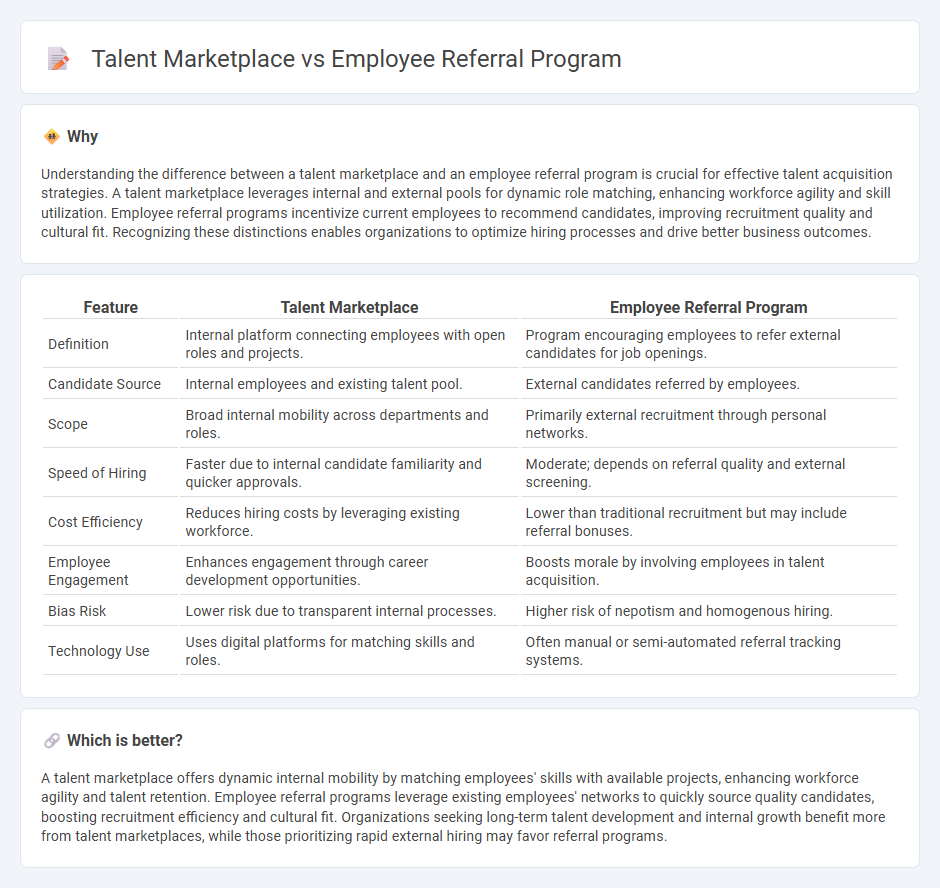
Talent marketplaces leverage advanced algorithms to match employees with internal opportunities based on skills and career goals, enhancing workforce agility and retention. Employee referral programs tap into existing employees' networks, driving high-quality candidate acquisition through trusted recommendations and cultural fit. Discover how integrating these approaches can optimize talent management and organizational success.
Why it is important
Understanding the difference between a talent marketplace and an employee referral program is crucial for effective talent acquisition strategies. A talent marketplace leverages internal and external pools for dynamic role matching, enhancing workforce agility and skill utilization. Employee referral programs incentivize current employees to recommend candidates, improving recruitment quality and cultural fit. Recognizing these distinctions enables organizations to optimize hiring processes and drive better business outcomes.
Comparison Table
| Feature | Talent Marketplace | Employee Referral Program |
|---|---|---|
| Definition | Internal platform connecting employees with open roles and projects. | Program encouraging employees to refer external candidates for job openings. |
| Candidate Source | Internal employees and existing talent pool. | External candidates referred by employees. |
| Scope | Broad internal mobility across departments and roles. | Primarily external recruitment through personal networks. |
| Speed of Hiring | Faster due to internal candidate familiarity and quicker approvals. | Moderate; depends on referral quality and external screening. |
| Cost Efficiency | Reduces hiring costs by leveraging existing workforce. | Lower than traditional recruitment but may include referral bonuses. |
| Employee Engagement | Enhances engagement through career development opportunities. | Boosts morale by involving employees in talent acquisition. |
| Bias Risk | Lower risk due to transparent internal processes. | Higher risk of nepotism and homogenous hiring. |
| Technology Use | Uses digital platforms for matching skills and roles. | Often manual or semi-automated referral tracking systems. |
Which is better?
A talent marketplace offers dynamic internal mobility by matching employees' skills with available projects, enhancing workforce agility and talent retention. Employee referral programs leverage existing employees' networks to quickly source quality candidates, boosting recruitment efficiency and cultural fit. Organizations seeking long-term talent development and internal growth benefit more from talent marketplaces, while those prioritizing rapid external hiring may favor referral programs.
Connection
The talent marketplace enhances internal mobility by matching employees' skills with open roles, complementing employee referral programs that source high-quality candidates from trusted networks. Both strategies leverage existing employee insights to improve hiring efficiency and retention rates. Integrating these systems optimizes workforce agility and drives strategic talent acquisition outcomes.
Key Terms
**Employee Referral Program:**
Employee Referral Programs leverage existing employees' networks to source qualified candidates, resulting in higher-quality hires and reduced recruitment costs. These programs boost employee engagement and retention by rewarding referrals and fostering a collaborative hiring culture. Explore how implementing an effective Employee Referral Program can transform your talent acquisition strategy.
Internal Recruitment
Employee referral programs leverage existing employees to identify and recommend qualified candidates, enhancing recruitment efficiency and cultural fit. Talent marketplaces utilize internal talent pools, matching employees with open roles based on skills and career goals, promoting internal mobility and retention. Explore how these internal recruitment strategies can transform your organization's talent acquisition.
Employee Incentives
Employee referral programs boost recruitment by offering monetary bonuses or other rewards to employees who successfully refer candidates, enhancing engagement and retention. Talent marketplaces emphasize skill-based project assignments and career growth opportunities, motivating employees through professional development incentives rather than direct financial rewards. Discover how these distinct employee incentives can transform your talent acquisition and retention strategies.
Source and External Links
8 Steps To Design an Employee Referral Program (With Free Sample) - This article provides a step-by-step guide on how to design and implement an effective employee referral program, including setting goals, creating incentives, and minimizing bias.
Employee Referral Program: Benefits & Strategies - Achievers - This webpage explores the benefits and strategies of employee referral programs, including how they work and examples of successful implementations by companies like Dropbox.
Want to Hire Top Talent? Here's How to Build an Employee Referral Program - This article discusses how employee referral programs can attract top talent by leveraging personal networks and fostering trust between the organization and its workforce.
 dowidth.com
dowidth.com